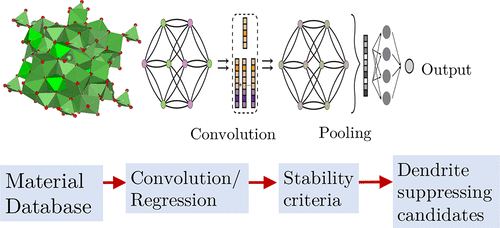当前位置:
X-MOL 学术
›
ACS Cent. Sci.
›
论文详情
Our official English website, www.x-mol.net, welcomes your feedback! (Note: you will need to create a separate account there.)
Machine Learning Enabled Computational Screening of Inorganic Solid Electrolytes for Suppression of Dendrite Formation in Lithium Metal Anodes
ACS Central Science ( IF 18.2 ) Pub Date : 2018-08-10 00:00:00 , DOI: 10.1021/acscentsci.8b00229 Zeeshan Ahmad 1 , Tian Xie 2 , Chinmay Maheshwari 1 , Jeffrey C. Grossman 2 , Venkatasubramanian Viswanathan 2, 3
ACS Central Science ( IF 18.2 ) Pub Date : 2018-08-10 00:00:00 , DOI: 10.1021/acscentsci.8b00229 Zeeshan Ahmad 1 , Tian Xie 2 , Chinmay Maheshwari 1 , Jeffrey C. Grossman 2 , Venkatasubramanian Viswanathan 2, 3
Affiliation

|
Next generation batteries based on lithium (Li) metal anodes have been plagued by the dendritic electrodeposition of Li metal on the anode during cycling, resulting in short circuit and capacity loss. Suppression of dendritic growth through the use of solid electrolytes has emerged as one of the most promising strategies for enabling the use of Li metal anodes. We perform a computational screening of over 12 000 inorganic solids based on their ability to suppress dendrite initiation in contact with Li metal anode. Properties for mechanically isotropic and anisotropic interfaces that can be used in stability criteria for determining the propensity of dendrite initiation are usually obtained from computationally expensive first-principles methods. In order to obtain a large data set for screening, we use machine-learning models to predict the mechanical properties of several new solid electrolytes. The machine-learning models are trained on purely structural features of the material, which do not require any first-principles calculations. We train a graph convolutional neural network on the shear and bulk moduli because of the availability of a large training data set with low noise due to low uncertainty in their first-principles-calculated values. We use gradient boosting regressor and kernel ridge regression to train the elastic constants, where the choice of the model depends on the size of the training data and the noise that it can handle. The material stiffness is found to increase with an increase in mass density and ratio of Li and sublattice bond ionicity, and decrease with increase in volume per atom and sublattice electronegativity. Cross-validation/test performance suggests our models generalize well. We predict over 20 mechanically anisotropic interfaces between Li metal and four solid electrolytes which can be used to suppress dendrite growth. Our screened candidates are generally soft and highly anisotropic, and present opportunities for simultaneously obtaining dendrite suppression and high ionic conductivity in solid electrolytes.
中文翻译:

基于机器学习的无机固体电解质的计算机筛选,用于抑制锂金属阳极中枝晶的形成
基于锂(Li)金属阳极的下一代电池在循环过程中受到锂金属在阳极上的树枝状电沉积的困扰,从而导致短路和容量损失。通过使用固体电解质来抑制树突生长已经成为使锂金属阳极能够使用的最有希望的策略之一。基于它们抑制与锂金属阳极接触的枝晶萌发的能力,我们对超过12000种无机固体进行了计算筛选。通常可以从计算上昂贵的第一原理方法中获得可用于确定枝晶萌发倾向的稳定性标准的机械各向同性和各向异性界面的属性。为了获得用于筛选的大数据集,我们使用机器学习模型来预测几种新型固体电解质的机械性能。机器学习模型仅针对材料的结构特征进行训练,不需要任何第一性原理的计算。我们在剪切模量和体积模量上训练图卷积神经网络,因为由于其第一原理计算值的不确定性低,因此具有低噪声的大型训练数据集的可用性。我们使用梯度提升回归和核岭回归来训练弹性常数,其中模型的选择取决于训练数据的大小和它可以处理的噪声。发现材料的刚度随质量密度的增加以及Li和亚晶格键离子化率的增加而增加,随每原子体积和亚晶格电负性的增加而降低。交叉验证/测试性能表明我们的模型具有很好的泛化能力。我们预测锂金属和四种固体电解质之间的20多种机械各向异性界面可用于抑制枝晶生长。我们筛选出的候选材料通常是柔软且高度各向异性的,并为同时获得固体电解质中的枝晶抑制和高离子电导率提供了机会。
更新日期:2018-08-10
中文翻译:

基于机器学习的无机固体电解质的计算机筛选,用于抑制锂金属阳极中枝晶的形成
基于锂(Li)金属阳极的下一代电池在循环过程中受到锂金属在阳极上的树枝状电沉积的困扰,从而导致短路和容量损失。通过使用固体电解质来抑制树突生长已经成为使锂金属阳极能够使用的最有希望的策略之一。基于它们抑制与锂金属阳极接触的枝晶萌发的能力,我们对超过12000种无机固体进行了计算筛选。通常可以从计算上昂贵的第一原理方法中获得可用于确定枝晶萌发倾向的稳定性标准的机械各向同性和各向异性界面的属性。为了获得用于筛选的大数据集,我们使用机器学习模型来预测几种新型固体电解质的机械性能。机器学习模型仅针对材料的结构特征进行训练,不需要任何第一性原理的计算。我们在剪切模量和体积模量上训练图卷积神经网络,因为由于其第一原理计算值的不确定性低,因此具有低噪声的大型训练数据集的可用性。我们使用梯度提升回归和核岭回归来训练弹性常数,其中模型的选择取决于训练数据的大小和它可以处理的噪声。发现材料的刚度随质量密度的增加以及Li和亚晶格键离子化率的增加而增加,随每原子体积和亚晶格电负性的增加而降低。交叉验证/测试性能表明我们的模型具有很好的泛化能力。我们预测锂金属和四种固体电解质之间的20多种机械各向异性界面可用于抑制枝晶生长。我们筛选出的候选材料通常是柔软且高度各向异性的,并为同时获得固体电解质中的枝晶抑制和高离子电导率提供了机会。



























 京公网安备 11010802027423号
京公网安备 11010802027423号